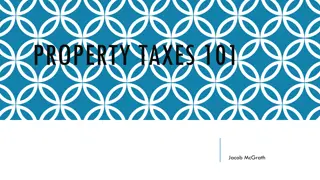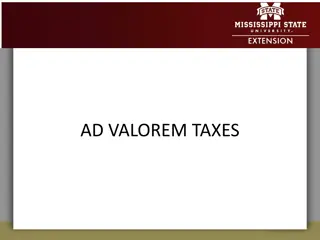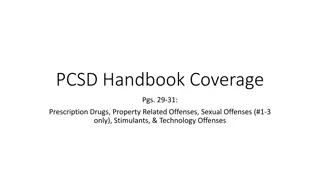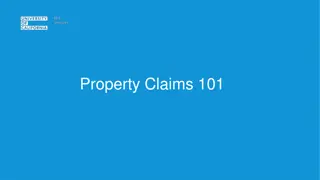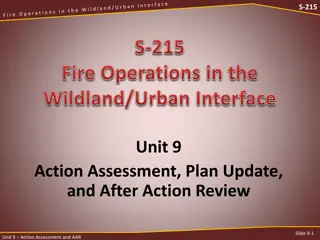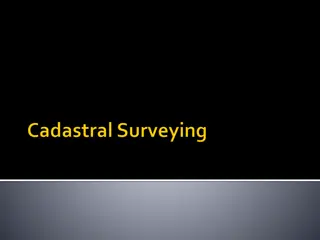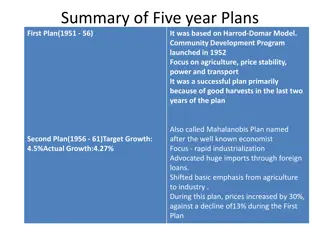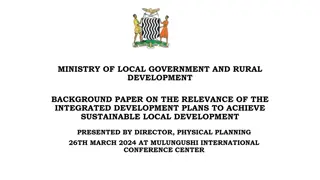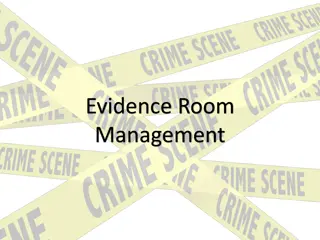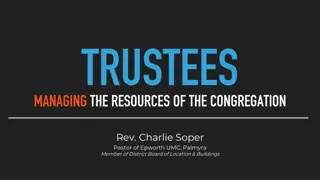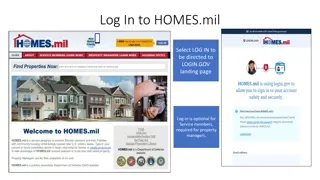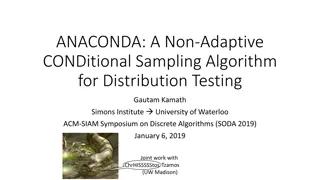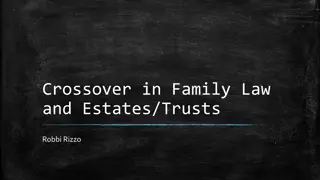Understanding Strata Plans and Common Property
In this informational document presented by Shawn M. Smith of Cleveland Doan LLP Strata Lawyers, you will learn about the different types of strata plans, including conventional and bare land plans, as well as the concept of common property and limited common property in strata developments. The document delves into the definitions and distinctions of these key terms, providing clarity on the responsibilities and rights associated with each category. Gain insights into strata lots, common property features like pipes and wires, and the exclusive use of limited common property areas such as decks and parking spaces.
Download Presentation

Please find below an Image/Link to download the presentation.
The content on the website is provided AS IS for your information and personal use only. It may not be sold, licensed, or shared on other websites without obtaining consent from the author. Download presentation by click this link. If you encounter any issues during the download, it is possible that the publisher has removed the file from their server.
E N D
Presentation Transcript
ALTERATIONS: EVERYTHING YOU EVER WANTED TO KNOW __________ Cleveland Doan LLP Strata Lawyers PRESENTED BY SHAWN M. SMITH
THE STRATA PLAN Strata plans come in two types: - conventional (shows buildings: apartments, townhomes or detached homes) - bare land (no buildings shown) Strata plans are divided into three different areas: strata lots, common property and limited common property
THE STRATA PLAN "common property" means (a)that part of the land and buildings shown on a strata plan that is not part of a strata lot, and (b)pipes, wires, cables, chutes, ducts and other facilities for the passage or provision of water, sewage, drainage, gas, oil, electricity, telephone, radio, television, garbage, heating and cooling systems, or other similar services, if they are located (i) within a floor, wall or ceiling that forms a boundary (A) between a strata lot and another strata lot, (B) between a strata lot and the common property, or (C) between a strata lot or common property and another parcel of land, or (ii) wholly or partially within a strata lot, if they are capable of being and intended to be used in connection with the enjoyment of another strata lot or the common property;
THE STRATA PLAN Certain types of common property (i.e. pipes, wires, ducts, etc.) are defined by their physical location (i.e. within in a boundary wall). "limited common property" "limited common property" means common property designated for the exclusive use of the owners of one or more strata lots; Typically LCP is: - decks, patios, balconies - parking spaces - storage LCP can also be common property that, by its nature, services only one strata lot - Louie v. Strata Plan VR-1323 (2015), 55 C.C.L.I. (5th) 217
THE STRATA PLAN "strata lot" "strata lot" means a lot shown on a strata plan Unless between strata lot and common property is the midway point of the wall, floor or ceiling s.68 SPA the strata plan says otherwise, the boundary Boundary between two strata lots is the midway point of the wall, floor or ceiling. LCP boundaries are determined by physical measurements set out on the plan.
THE STANDARD BYLAWS s.120 SPA except to the extent that contrary bylaws are filed in the Land Title Office (LTO) the Standard Bylaws are the bylaws of the strata corporation. Most strata corporations use the Standard Bylaws when it comes to alterations. Those supplemented s.128 SPA. bylaws can be replaced, amended or
THE STANDARD BYLAWS Standard Bylaw 5 addresses alterations to strata lots and consequential alterations to the common property. Standard Bylaw 6 addresses alterations to the common and limited common property. Both require an owner to obtain written permission before undertaking work. A key difference between the two is that approval under Standard Bylaw 5 cannot be unreasonably withheld. Where approval is withheld the strata council needs to have a justifiable reason for doing so.
THE STANDARD BYLAWS Standard Bylaw 5 captures changes to: (a) the structure of a building; (b) the exterior of a building; (c) chimneys, stairs, balconies or other things attached to the exterior of a building; (d) doors, windows or skylights on the exterior of a building, or that front on the common property; (e) fences, railings or similar structures that enclose a patio, balcony or yard; (f) common property located within the boundaries of a strata lot; (g) those parts of the strata lot which the strata corporation must insure under section 149 of the Act.
THE STANDARD BYLAWS Standard Bylaw 5(1)(g) those parts of the strata lot which the strata corporation must insure under section 149 of the Act. Under s.149 the strata corporation is required to insure: (a) buildings shown on the strata plan, and (b) fixtures built or installed on a strata lot, if the fixtures are built or developer as part of the original construction on the strata lot. installed by the owner
THE STANDARD BYLAWS Regulation 9.1 fixtures includes items attached to a building, including floor electrical and plumbing fixtures, but does not include, if they can be removed building, refrigerators, microwaves, washers, dryers or other items and wall coverings and without stoves, damage dishwashers, to the As a result Bylaw 5(1) applies to work involving: Flooring Cabinets Plumbing fixtures (ie. tubs and showers) Fireplaces Stairs
THE STANDARD BYLAWS BARE LAND STRATA CORPORATIONS: Standard Bylaw 5 does not apply. Absent a registered building scheme, there are no restrictions on what can be built. Can enact bylaws which control what can be built, where it can be built, etc. Cannot restrict things which a building scheme allows - Winchester Resorts Inc. v. Strata Plan KAS2188 (2002), 4 B.C.L.R. (4th) 390.
WHAT IS AN ALTERATION? The consideration by the Ontario Superior Court of Justice in Wentworth Condominium McMahon 2009 CarswellOnt. 1273. term alteration was first given judicial Corporation 198 v. alteration structure . means something that changes the But what does that really mean? What is a change? What is meant by structure?
WHAT IS AN ALTERATION? The Owners, Strata Plan NWS254 v. Hall 2016 BCSC 2363. Here, the work involved the removal and replacement of four windows and the patio door. The replacement of the windows and door did not change the structure of the did not change the structure of the respondent s unit, or the common property respondent s unit, or the common property. I conclude that the replacement of the four windows and the patio door was not an alteration within the meaning of ss.5(1) or 6(1) of the Standard Bylaws requiring the prior approval in writing of the Strata Corporation. Bottom Line: Replacing like for like is not an alteration Bottom Line: Replacing like for like is not an alteration.
WHAT IS AN ALTERATION? Allwest International Equipment Sales Co. v. The Owners, Strata Plan LMS4581 2018 BCCA 187 An alteration is something that changes the building (i.e. makes it different) What is meant by structure doesn t really matter. The change must have an element of materiality to it. Court of Appeal confirmed that cutting a 2 inch hole in a wall was enough to be an alteration.
WHAT IS AN ALTERATION? Allwest has far reaching implications for interior work. Standard Bylaw 5(1)(g) includes within its scope: items attached to a building, including floor and wall coverings and electrical and plumbing fixtures . Almost replacement (like for like) would be caught by it. anything that is not a routine repair or Consider whether that is what owners want.
WHAT IS AN ALTERATION? Some examples of minor things being considered alterations are: BCCRT connect a dishwasher would alter common property. Wilchek v. The Owners, Strata Plan VR 55, 2017 67 Minor plumbing work necessary to BCCRT 184 - painting exterior French doors a different colour was an alteration . Friedrich v. The Owners, Strata Plan K515, 2018
WHAT IS AN ALTERATION? 2018 BCCRT 7 the installation of doorbell cameras and video surveillance cameras alterations. Parnell v. The Owners, Strata Plan VR 2451, were considered drilling of lag bolts into joists to support a medical left system was held to be an alteration because of the impact on the strength of the joists. Boyer v. Downey et al, 2018 BCCRT 156 the
WHAT IS AN ALTERATION? Standard Bylaw 6 common property has limitations when it comes to changes to patios, decks, balconies and yard areas. not alteration (or even an addition or improvement). everything that is done will constitute an much will turn on how the item is constructed or where it is placed.
WHAT IS AN ALTERATION? Term alteration is not uniformly applied when it comes to structures: hot tub is not an alteration - The Owners, Strata Plan LMS4255 v. Newell 2012 BCSC 1542 gazebo-type structure on a patio was an alteration - Giddings et al v. The Owners, Strata Plan BCS 3620, 2018 BCCRT 61 construction alteration or addition or doing a renovation or other work - Zhang v. The Owners, Strata Plan BCS1115 2017 BCCRT 79 of an arbour in a back yard was an
WHAT IS AN ALTERATION? Changes to landscaping generally considered an alteration: planting of trees and bushes on the common property - Wu v. Hu and The Owners, Strata Plan BCS 3579, 2017 BCCRT 81. planting of trees, the removal of a hedge and its replacement with a fence, the construction of patio and the installation of drainage were alterations - Anthony v. Schnapp 2016 BCSC 1839 placement of large vegetable boxes, installing a fence and planting a garden is an alteration - Friedrich v. The Owners, Strata Plan K515, 2018 BCCRT 18
SPECIAL KINDS OF ALTERATIONS Habitable residential strata lot which can be lived in, but does not include patios, balconies, garages, parking stalls or storage areas other than closet space. area is defined as the area of a It entitlement which in turn determines its share of the common expenses. is used to determine each strata lot s unit Those considered habitable area are identified on the strata plan. portions of the strata lot which are not
SPECIAL KINDS OF ALTERATIONS s.70(4) of the SPA Subject to the regulations, if an owner wishes to increase or decrease the habitable part of the area of a residential strata lot, by making a nonhabitable part of the strata lot habitable and the unit entitlement of the strata lot is calculated on the basis of habitable area or on the basis of square footage in accordance with section 1 of the Condominium Act , the owner must: (a) Entitlement under section 261, and seek an amendment to the Schedule of Unit (b) before making the change. obtain the unanimous vote referred to in section 261
SPECIAL KINDS OF ALTERATIONS Regulation 5.1(2) exempts an owner from the unanimous vote requirement where the increase to the habitable area, combined with any previous increase to the habitable area, is: less than 10% of the habitable area of the strata lot and less than 20 square metres. The prior written approval of the strata corporation, as set out in the bylaws, is still required. Typical situation where s.70(4) applies is enclosing a garage or part of it
SPECIAL KINDS OF ALTERATIONS Enclosing common or limited common property (i.e. a balcony) does not trigger a change in the unit entitlement. Unit entitlement is based on the habitable area of the strata lot, not areas outside it. Changing the way in which common property is used by enclosing it does not change its nature; it is still common property.
SPECIAL KINDS OF ALTERATIONS Removing a wall between two strata lots s.70(1) and (2) of the SPA. Permission cannot be refused so long as the work complies with: (i) a building regulation within the meaning of the Building Act,(i.e. the Building Code); and (ii) any applicable municipal or regional district bylaws Must not interfere with the provision of utilities or other services to any other strata lot or to the common property. Does not create a single new strata lot.
HUMAN RIGHTS CODE 8 (1) justification, A person must not, without a bona fide and reasonable (a) deny to a person or class of persons any accommodation, service or facility customarily available to the public, or (b) discriminate against a person or class of persons regarding any accommodation, customarily available to the public service or facility because of the race, colour, ancestry, place of origin, religion, marital status, family status, physical or mental disability, sex, sexual orientation, gender identity or expression, or age of that person or class of persons
HUMAN RIGHTS CODE The Code applies to strata corporations because they are providing services - Konieczna v. The Owners Strata Plan NW2489 2003 BCHRT 38. Strata corporation is obligated to accommodate a person with a disability to the point of undue hardship see Mahoney obo Holowaychuk v. The Owners, Strata Plan NW332 et al 2008 BCHRT 274. each party has certain obligations with respect to establishing the need for the accommodation accommodation options - Leary v. Strata Plan VR1001, 2016 BCHRT 139 and alternative
HUMAN RIGHTS CODE When considering a request for permission involving the Code, the Tribunal has said: I disagree with the submission of the Strata Council that it cannot consider specific or special needs of its unit owners. However, I agree with its submission Calderoni follow the procedure set out in its by-laws, regarding a proposed renovation, is not a contravention of the Code. In my view, the Strata Council has a duty to ensure that it bases its review of a proposed modification of a unit on adequate and reliable information and plans. that requiring Mrs. Calderoni v. Strata Council Plan No. K6 2009 BCHRT 10
GIVING PERMISSION Standard Bylaws 5 and 6 both refer to the permission of the strata corporation. In most cases that means the permission of the strata council. Under ss.4 and 26 of the SPA the strata council performs the powers and duties of the strata corporation. s.71 - the strata corporation must not make a significant change in the use use or appearance appearance of common property unless approved by a vote
GIVING PERMISSION When is an alteration significant ? Factors to consider: (1) visibility or non-visibility to residents and its visibility or non-visibility towards the general public; A change would be more significant based on its (2) the use or enjoyment of a unit or a number of units or an existing benefit of a unit or units; Whether the change to the common property affects (3) result of the changed use? Is there a direct interference or disruption as a
GIVING PERMISSION (4) value of the unit? Does the change impact on the marketability or (5) significant along with the general use, such as whether it is commercial, residential or mixed use; and The number of units in the building may be (6) corporation has governed itself in the past and what it has allowed. For example, has it permitted similar changes in the past? Consideration should be given as to how the strata
GIVING PERMISSION Examples of significant changes: the installation of garden lighting - O Neill v. The Owners, Strata Plan LMS 898, 2018 BCCRT 20; the placement of a gazebo on a patio - Giddings et al v. The Owners, Strata Plan BCS 3620, 2018 BCCRT 61; extension of a deck and installation of railings Foley v. The Owners, Strata Plan VR387 2014 BCSC 1333. Planting of garden beds and fruit trees, removing a hedge and constructing a fence Anthony v. Schnapp 2016 BCSC 1839
GIVING PERMISSION Requests for permission can be made in writing or by asking for a hearing under s.34.1 of the SPA. Under s.34.1 a hearing must be held within 4 weeks and written decision provided within 1 week afterwards. No deadline to respond to a written request. Two month delay was okay where there was a reason for it - Grant v. The Owners, Strata Plan BCS 337, 2018 BCCRT 70 Council cannot call an emergency meeting to approve a request. An owner s lack of planning is not an emergency.
GIVING PERMISSION Standard Bylaws require approval to be in writing writing Be very clear and detailed about what was approved. It helps when the owner expands the scope of work. Council has discretion to impose conditions even though the bylaws don t say so - The Owners, Strata Plan BCS 983 v. Muir, 2018 BCCRT 157 Nonetheless, the bylaws should list the conditions so owners are aware in advance and council has some parameters within which to work.
GIVING PERMISSION Some of the major things to be concerned about: Structural changes (are they safe?) Is a building permit required? (Onus should be placed on the owner to prove one is not required) Who is doing electrical and plumbing work? Flooring noise impact and how to minimize Is a change to the development permit required?
GIVING PERMISSION Some examples of when a building permit is required when you: Make alterations, additions or repairs to an existing building Complete a previously unfinished area in an existing building, Make interior structural renovations Remodel or construct a deck Install or alter plumbing within a building Install a new chimney or fireplace Enclose your carport or change your garage to living space (Regional District of Nanaimo website)
GIVING PERMISSION Some examples of when a building permit is not not required for: Installing cupboards Roofing repairs or replacements (providing that no structural changes are made) Exterior finish repair or replacement (e.g., stucco or siding, providing that no structural changes are made) Landscaping or sidewalks Fences less than 2 meters in height (Regional District of Nanaimo website)
GIVING PERMISSION Three alterations: areas of concern re common property Builders Liens Worksafe coverage Warranties for previous work (the alteration could limit the applicability of warranties for building envelope repairs and other work)
GIVING PERMISSION Common property is owned by all owners as tenants-in- common - s.66 SPA Strata corporation controls the common property on behalf of the owners s.3 SPA Since there is not a separate title for common property, liens for work done on or to the common property get registered against title to the strata lots Where coverage, they are liable for the costs related to an injury suffered by a worker. someone employs trades without Worksafe
GIVING PERMISSION Does some sort of exclusive use designation need to accompany the permission? Friedrich v. The Owners, Strata Plan K515, 2018 BCCRT 184 the owner did extensive improvements to the yard behind their strata lot Effectively enclosed the area with plantings and a fence CRT designation ordered the owner to apply for exclusive use
GIVING PERMISSION Exclusive use designated in one of two ways: Short term exclusive use under s.76 SPA Must be renewed annually Can be revoked on reasonable notice Is granted to a person, not a strata lot Limited common property designation under s.74 SPA Approved by vote at AGM/SGM Carries over to the next owner
ASSUMPTION OF LIABILITY Under the Standard Bylaws, a strata corporation can require an owner to: agree, expenses relating to the alteration. in writing, to take responsibility for any Commonly referred to as an Assumption of Liability Agreement (ALA) or an Indemnity Agreement . Purpose is to ensure that the strata corporation does not incur additional repair and maintenance costs as a result of the alteration.
ASSUMPTION OF LIABILITY Refusal to sign an ALA is a breach of the strata corporation s bylaws Corner v. The Owners, Strata Plan K833 2017 BCCRT 89. Failure to take action where an owner doesn t sign one when required can lead to the strata corporation being responsible for the costs to repair -Allard v. The Owners, Strata Plan VIS 962, 2017 BCCRT 111
ASSUMPTION OF LIABILITY Critical when the alteration relates to or impacts an area which the strata corporation is obligated to repair and maintain under the SPA or its bylaws. Not always necessary for alterations to a strata lot interior since the owner is already responsible to repair and maintain the strata lot. They cannot make the owner responsible for repairs and maintenance for which the strata corporation would otherwise be responsible.
ASSUMPTION OF LIABILITY The existence of an ALA has to be disclosed on a Form B. Item (c) requires: Are there any agreements under which the owner of the strata lot described above takes responsibility for expenses relating to alterations to the strata lot, the common property or the common assets? __no __ yes [attach copy of all agreements] A failure to disclose an ALA on the Form B will make strata unable to make a new owner responsible for costs related to an alteration s.59(5) SPA
ASSUMPTION OF LIABILITY Form B and s.59 would appear to imply that a new owner is automatically bound by the terms of the ALA signed by the prior owner. However, that may not be the case. Easement cases: positive covenants only binding on the parties to the original agreement, not successor owners; unless those successor owners have agreed in writing to be bound by those agreements.
ASSUMPTION OF LIABILITY Two ways to address this potential problem: new owners sign the assumption agreement; or have a procedure (and bylaw) in place to have for additional costs where that was term of the original approval. pass a bylaw which makes owners responsible
REPAIRS AND MAINTENANCE ALA does not make an owner responsible to actually carry out repairs, only to reimburse the strata for the costs of doing so. Making an owner responsible for repairs requires an amendment to the bylaws. In the case of common property, s.72(2)(b) does not allow that.


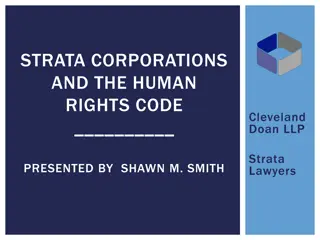
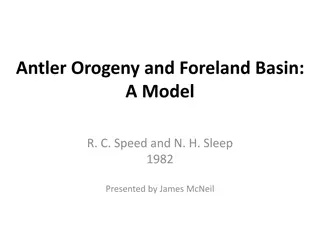
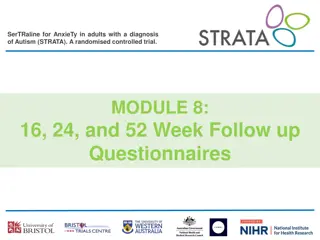
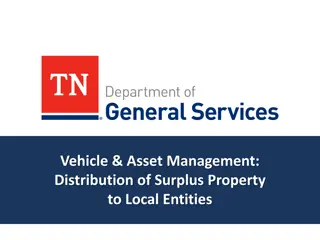

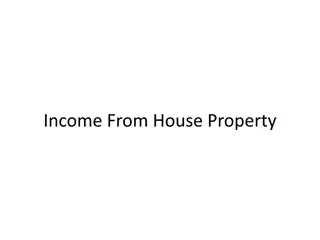

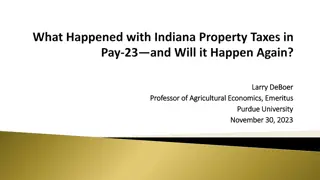
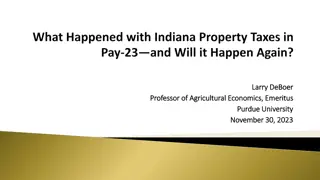
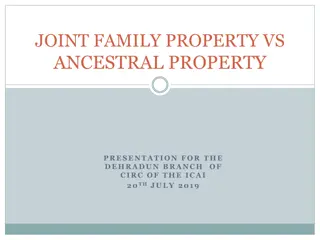

![Property Settlements in Family Law: Case Study of Stamatou & Stamatou [2022] FedCFamC1F 241](/thumb/63303/property-settlements-in-family-law-case-study-of-stamatou-stamatou-2022-fedcfamc1f-241.jpg)
